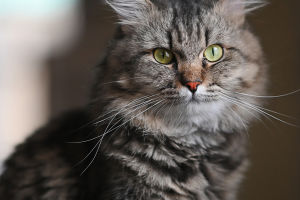
Winter Cat Care

Winter has arrived, and many people enjoy dressing up their small pets to keep them warm, especially cats, who are often perceived as sensitive to the cold. This raises a common question: Do cats really need to wear thick clothing to stay warm?
The fur of a cat naturally provides excellent warmth. When we dress our feline friends in clothes, it can hinder their skin from breathing, potentially causing dermatitis.
While grooming your cat, you might notice white flakes if their skin isn't getting enough air.
Moreover, a cat's fur has its own built-in temperature regulation, so forcing them into clothes could disrupt their ability to adapt and may even lead to hormonal imbalances.
Constantly changing between wearing and not wearing clothes can make your cat more susceptible to illness and the cold.
Related
 Learn more about the heron's appearance, distribution, habits, and lifestyle, as well as its important role in the ecosystem.
Learn more about the heron's appearance, distribution, habits, and lifestyle, as well as its important role in the ecosystem.
 The graceful egret lives in a variety of waters and has an array of fascinating characteristics.
The graceful egret lives in a variety of waters and has an array of fascinating characteristics.
 The white-headed ibis stork is one of the most endangered birds in the world, with its population declining rapidly.
The white-headed ibis stork is one of the most endangered birds in the world, with its population declining rapidly.
 Giraffes, Earth's tallest land animals, captivate with their unique features and behaviors, inhabiting Africa's open landscapes.
Giraffes, Earth's tallest land animals, captivate with their unique features and behaviors, inhabiting Africa's open landscapes.
 Uncover the secrets of short-term and long-term memory in cats.
Uncover the secrets of short-term and long-term memory in cats.
 Chrysolophus pictus is a spectacular and colorful bird species native to the forests of China.
Chrysolophus pictus is a spectacular and colorful bird species native to the forests of China.
Cats rely on their fur for more than just warmth; it also serves as a protective barrier. Cats strongly dislike getting their fur wet, and their fur helps keep them dry in damp conditions.
When cats are dressed in clothing, their mobility can be significantly hindered, making it challenging for them to move freely. Some cats even resort to tearing at their clothes, which, if ingested, can lead to gastrointestinal problems - a serious concern.

If you choose clothes that aren't well-suited for cats or are made from low-quality materials, they can chafe the cat's necks, causing discomfort and increased scratching in these areas.
Overweight cats might find it difficult to breathe when clothes are too tight, leading them to prefer lying down rather than moving around.
In addition to the physical discomfort, wearing clothes can also cause emotional stress for some cats. When the clothes are removed, cats may exhibit frantic scratching behavior as a way to release pent-up anxiety.
So, what should you consider if you want to dress your cat for warmth in the winter? Firstly, it's essential to choose clothes specifically designed for cats. These garments should fit comfortably and allow for easy movement.
Look for materials that are soft, breathable, and non-restrictive. Pay attention to your cat's behavior while they are in the clothing; if they seem uncomfortable or distressed, it might be best to remove the clothes.
It's also crucial to monitor your cat's body temperature. Some cats tolerate the cold better than others, so assess your cat's individual needs.
If you notice shivering or signs of discomfort, it may be time to consider adding some additional warmth to their environment, such as providing a heated bed or increasing the ambient temperature in your home.